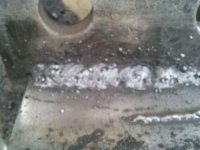Gary Fowler
Super Star Member
- Joined
- Jun 23, 2008
- Messages
- 11,917
- Location
- Bismarck Arkansas
- Tractor
- 2009 Kubota RTV 900, 2009 Kubota B26 TLB & 2010 model LS P7010
I would think that if you follow the sketch on the attachment thread with all the gussets on it, a 1/4" fillet would be sufficient. If you bevel the plates so you get at least half the thickness ( 1/3 on each side and 1/3 unbevelled) then top with 3/8 fillet weld, it will never break if the weld is solid. If you can weld it flat or slightly inclined, E 7018 in either 3/32 or 1/8" size will work in the tombstone Lincoln. About 125-150 amps should weld good in flat or slightly inclined uphill for the 7018 works best for beginner welders.. I would use the 6011 as a first pass then fill it and cap with the 7018. They are stronger and more ductile than the 60xx series rods. Just keep as short an arc as possible without them sticking. Get the AC version of the 7018 for your crackerbox welder. The tombstone welders like to run a longer arc to avoid the rod sticking which makes it aggravating somewhat with the 7018 as they need a short arc length to weld properly but the 7018AC helps with that. I have used hundreds of pounds of DC 7018 with Lincoln Tombstone welders back in 60's and 70's when all I had was the AC machine and 7018 AC was not made yet and other than hard to start and occassionally arcing out, the weld was strong. I even welded cast steel and stainless steel with them with good results although the welds would rust on the stainless.
